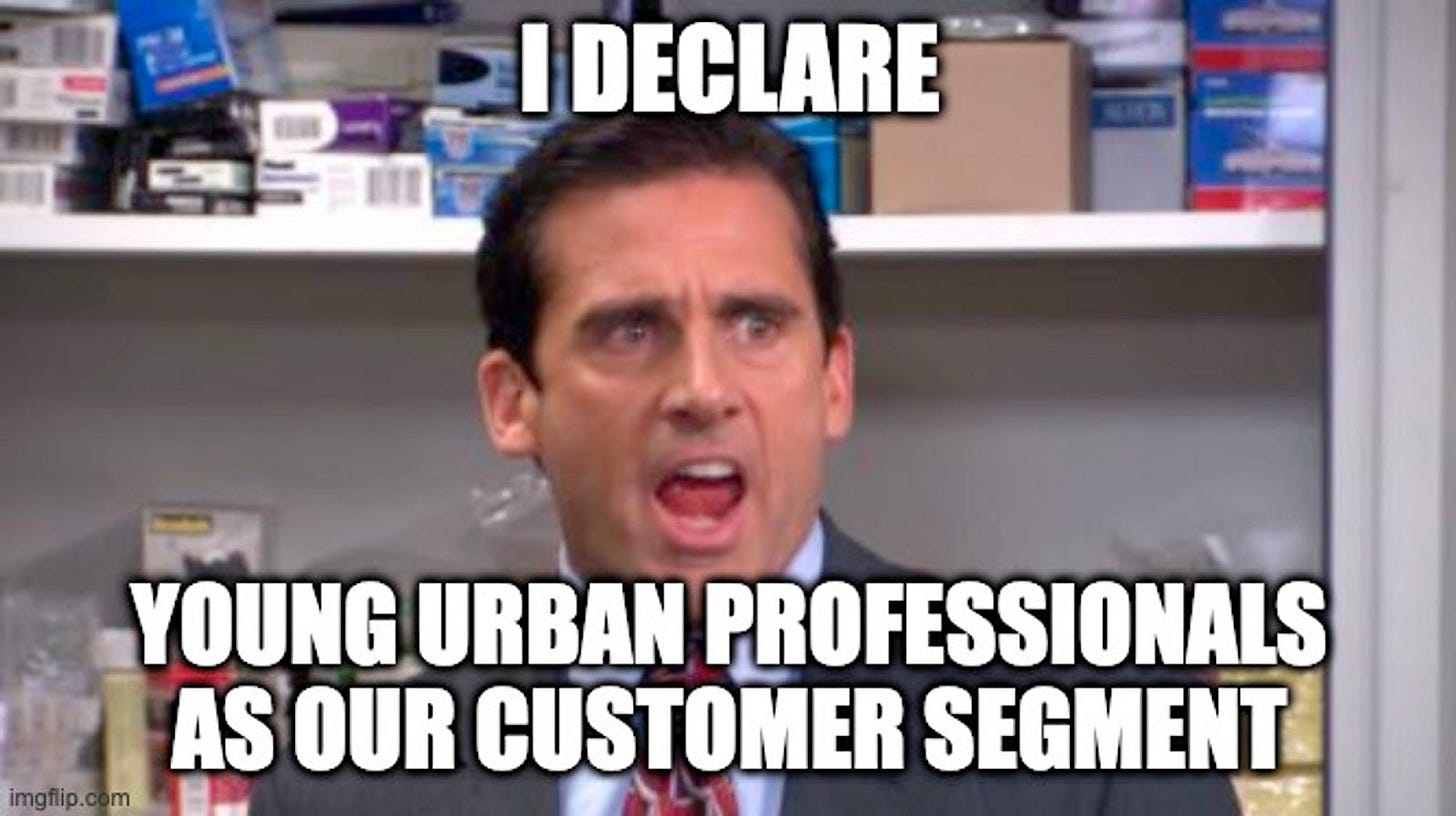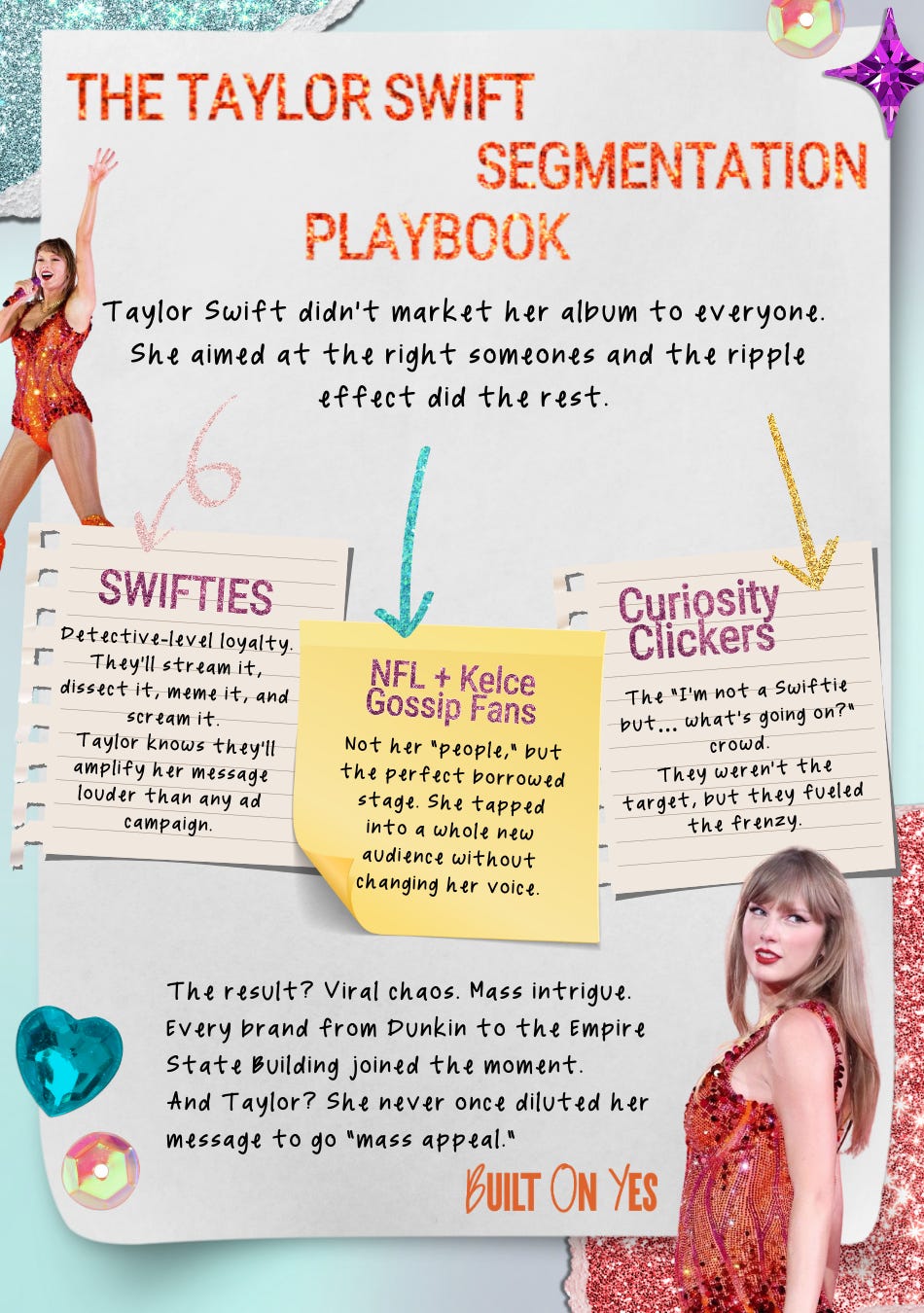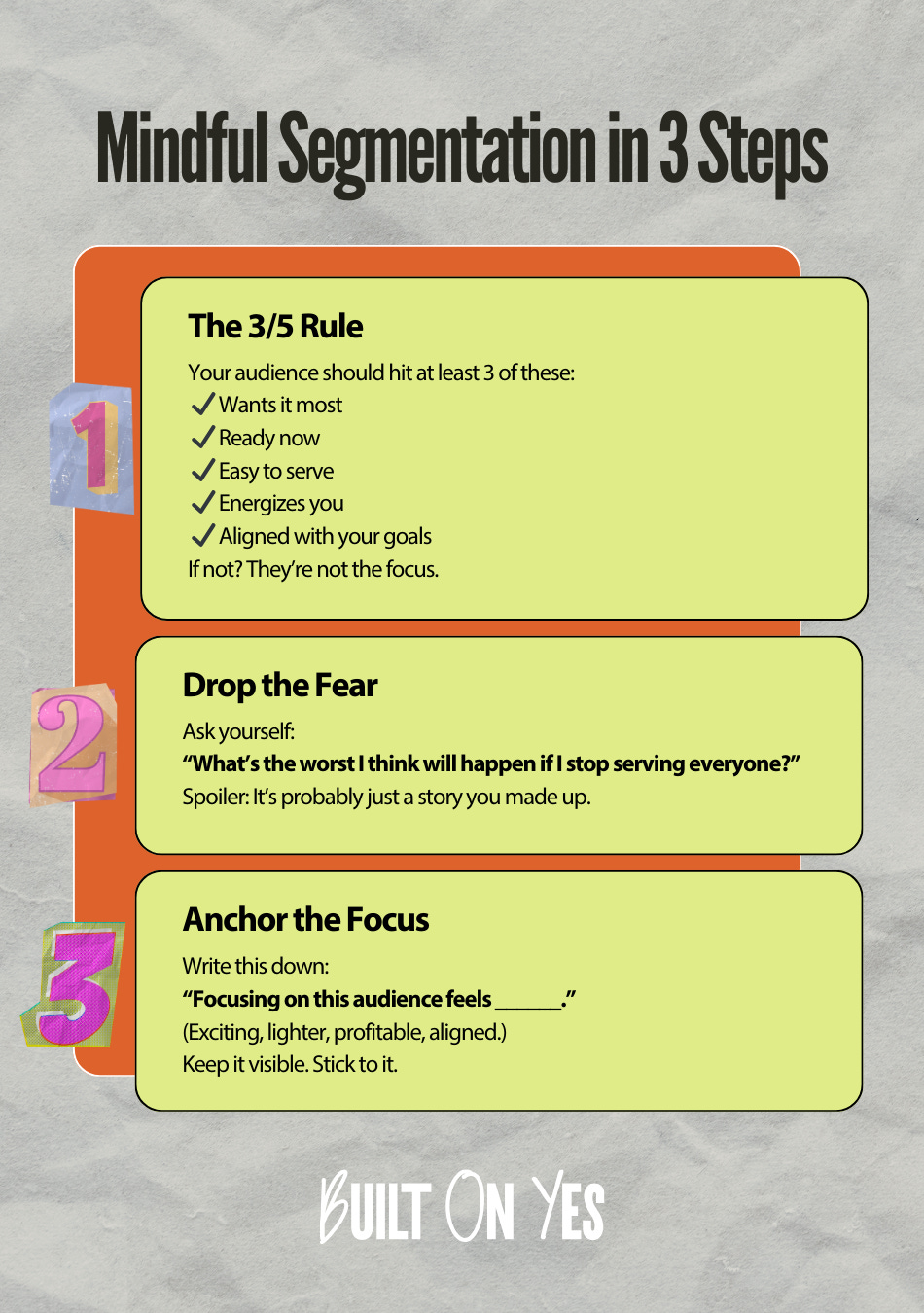Segmentation: The Business Superpower You’re Probably Ignoring
(Or, why deleting subscribers made my business stronger, and why you should find your Swiftie segment too.)
Hey there, Erin here!
This week’s blog is all about segmentation of your target audience.
I used to think more subscribers meant more success, until I realized half of them didn’t even know what Built on YES was. It’s like throwing a dinner party and realizing most of your guests wandered in from your neighbor’s house.
OR, even better… are you building a biz of an audience that is camping out for your next album drop and watching your boyfriend’s podcast, or are you trying to market to the Dads, Brads, and Chads who don’t even give AF?
Don’t worry, this blog is for the BFDs and the Swifties.
The Backstory: From “More Subscribers” to “More of the Right Subscribers”
Last week, I shared how knowing your target audience is different from thinking you know your target audience. This week, I’m pulling back the curtain on a shift I made that skyrocketed my engagement, open rates, and clarity — even though it meant cutting my list in half.
As you may or may not know, I’ve been a blogger for what seems like forever, I’ve always enjoyed writing and rambling about things I love. I’ve collected email addresses over the course of the past decade and more, plus all of the emails from the yoga studio, and now Substack and Built on YES.
When I started sharing what I was learning in my MS in Entrepreneurship program with other female founders, I sent it to my yoga audience. Why? Because it was mindfulness-inspired and it was who was in front of me at the time. The problem? They weren’t actually my ideal audience.
Then, after the studio closed, I took all the addresses, dumped them into Built on YES, and proudly told myself, “Look at all these subscribers!” Except… most of them never opened a single thing.
The Big Shift: Delete to Grow
A few weeks ago, I took my own advice and segmented my audience — and then hit DELETE on everyone who had never interacted with Built on YES.
Why?
Because they weren’t my people.
And I don’t want to waste time speaking to an empty room.
The result:
Higher open rates
Higher click-throughs
Actual conversations with readers who care
Sure, my numbers dropped. But my audience quality skyrocketed, and in business, quality always beats vanity metrics. Every. Single. Time.
Segmentation is a HUGE piece of the business basics puzzle. It’s not just about who your audience is, but why they are engaging with you, and what value you are bringing to them.
Remember: YOU ARE NOT FOR EVERYONE.
What Segmentation Really Means
Segmentation is not just “knowing your audience.” It’s knowing what they engage with, why they care, and how you can serve them better than anyone else.
Segmentation IS:
Choosing a focused group you can serve deeply and well
Understanding their shared needs, desires, and behaviors
Speaking directly to them so they feel seen
Segmentation is NOT:
Making something for every possible buyer
Watering down your message so “everyone” relates
Feeling guilty for not serving everyone
Truth Bomb: “Women 25–55 who like coffee and yoga” is not a segment. That’s a census report, babe.
The Taylor Swift Masterclass in Segmentation
Ready for an amazing pop culture example: Taylor Swift’s new album drop. Okay, okay, so I don’t exactly know if you (my target audience) are into TSwift, but this segmentation of biz strategy meets pop culture for sure does. And honestly, it’s an insanely relevant example in real time.
When Taylor Swift dropped The Life of a Showgirl on Travis Kelce’s podcast, she didn’t aim for “everyone who likes music.”
She went straight for her core segment: the diehard Swifties. Bonus: it was on a platform that also strategically tapped into two additional segments.
Primary Segment: Diehard Swifties
Already primed, waiting, and ready to stream, dissect, and share. These fans are honestly borderline detectives when it comes to everything TSwift related. She knows they will analyze, theorize, and share share share.
Secondary Segment: NFL + Kelce/Taylor gossip fans
New audience access without changing her brand voice.
Cross-pollination at its finest, because honestly, the annoying “Dads, Brads, and Chads” don’t want to hear her…but her fan base is WAY bigger.
She knows the gossip is BIG, which leads into the next segmentation…
Overlap Segment: Cultural curiosity seekers
The “I’m not a Swiftie, but I need to see what the fuss is about” group.
They weren’t the goal, but they are an added bonus. (Reminder: This isn’t who she strived for with joining her boyfriend’s podcast. She knew the diehards would flip their f*cking sh*t.)
The takeaway? She didn’t dilute her message for mass appeal… the masses grabbed her messaging and ran with it.
She picked her lane, strategically borrowed someone else’s audience, and let intrigue do the rest. She knew going on Travis and his brother’s podcast would create vitality and absolute chaos. She also knows her diehard fans analyze everything, and the podcast was totally unexpected prior to the drop.
This is just a lil’ personal bonus, I actually wrote this blog BEFORE the podcast was released on 08/13: I loved watching this preview drop ripple through the advertising and marketing world of big and small brands everywhere. The moment her sneak peek of the cover dropped, brands like Sharpie, Dunkin, Oh Norman!, Elmo, M&Ms, and even the Empire State Building were turned orange, glittery, or gave a clear nod to her via their marketing. F*cking everyone was talking about her new album.
Real-Life Segmentation in My Businesses
Since we aren’t all TSwift, let’s get back to some other real-life segmentation work…the yoga studio and Built on YES.
YESyoga Segments:
Stay-at-home moms
Working professionals
Yogi diehards
Injured newbies
People stressed the f*ck out
Built on YES Segments:
Female founders ready to scale without burning out
Women entrepreneurs seeking mindful business strategy
Solopreneurs craving systems and processes
Side-hustlers ready to take their business full-time
When I deleted those Built on YES subscribers that I mentioned above, it was because they most likely didn’t fit into one of these segments. So, they were gone.
Reality Inventory: The Mindful Segmentation Filter
If you’re stuck in “maybe I’ll serve corporate execs, college kids, and couples with a dog,” run your possible audiences through this filter before you say yes to another launch idea…
Step 1: Answer the following…
Desire — Who wants this most?
Readiness — Who is ready to buy, use, or commit right now?
Ease — Who is the easiest for you to work with or serve?
Energy — Who lights you up instead of draining you?
Alignment — Who matches your values and business goals?
Pro tip: If an audience doesn’t check at least 3 out of 5, it’s not your focus right now.
Think about it like this:
If you’re in a coaching business: Focus on scaling solopreneurs ready to invest, not beginners who “just want to pick your brain.”
If you’re in a dog training business, focus on those who just got a puppy, not “people who love dogs.”
Step 2: Call Out the Fear
What am I afraid will happen if I stop serving certain groups?
Is that fear based on fact or “made-up worst-case scenarios”?
Where have I been holding onto vanity metrics (like subscriber counts) instead of engagement?
Step 3: Mindful Anchor Statement
Finish this sentence:
“Focusing on this segment feels ____________.”
(Examples: lighter, more exciting, less stressful, profitable, aligned.)
Keep this in front of you, on a Post-it, phone note, or taped to your laptop, that way you don’t slide back into “everyone mode.”
The Wrap-Up
You’re not deleting people. You’re making space for the ones who want what you actually do.
Focus is freedom.
Segmentation isn’t about cutting people out, it’s about clearing space for the right ones. It’s building your biz to service with purpose, on purpose.
You’re courageous, capable, and strong enough to choose your focus and trust that your growth will come from depth, not scatter.
So… what’s your Swiftie segment?




